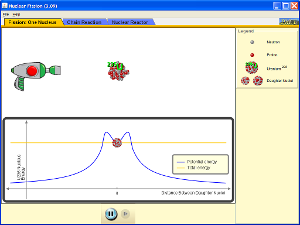Nuclear Weapons
Fission Bombs (also known as atomic bombs or A-bombs) The easily fissionable nuclides used are U-233, U-235 and Pu-239. Of these three, only U-235 occurs in nature, although less than 1% of natural uranium atoms are the U-235 isotope. The vast majority are U-238. All 3 of these nuclides are naturally radioactive: they decay by alpha emission and spontaneous fission. (Indeed, all nuclides with Z>82 are unstable.) They decay at a leisurely rate, though: the halflife of U-235 is over seven hundred million years.
Because Uranium is mostly U-238, not the fissionable U-235 isotope, much of the difficulty in making the simplest nuclear bomb is not in making the bomb itself; rather, it is in how to separate the U-235 atoms from U-238. That process isn't the topic of these notes, however.
Chadwick's discovery of the neutron in 1932 (aside from the novelty of another subatomic particle) had one important and immediately-obvious-to-everyone application: it is an ideal projectile with which to bombard nuclei. Being neutral, it is not affected at all by the negative charge of the electrons on the outskirts of the atom, nor the positive charge of the nucleus. Alpha particles, which Rutherford and everyone else had been using by default, needed to have extremely high energies in order to overcome the repulsion of the likewise positive nucleus. So ‘fissionable’ means that one of these nuclei can be induced to fragment by bombarding it with neutrons from the outside. The nucleus absorbs the neutron as well as whatever kinetic energy it possesses, becoming for a brief time an excited, higher-mass U-236 nucleus. This doomed nucleus promptly breaks into several pieces — usually two large fragments and several neutrons. Gamma-ray photons are also emitted. (In a small percentage of cases, the U-236 nucleus will de-excite by gamma emission, and not fragment. We will ignore that, though, because most will fission.)
|
 |
The energy liberated (200 MeV, typically) is in the form of KE of the fragments (that is, thermal energy) and high-energy photons. The photons are quickly absorbed, contributing to the total thermal energy of the material.
,_lecturing_at_Catholic_University,_Washington,_D.C.,_1946.jpg)
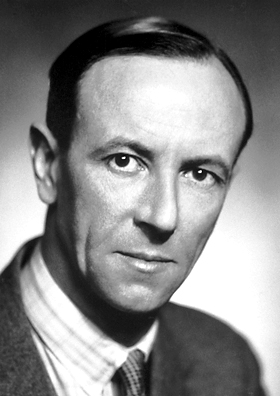 James Chadwick (above) discoverer of the neutron; Lise Meitner (below) discovered of nuclear fission.
James Chadwick (above) discoverer of the neutron; Lise Meitner (below) discovered of nuclear fission.
Barium and krypton are not the only fission products possible. Some of the U-235 atoms split in this fashion:
| In fact, there are a multitude of possible products. The only constraint is that the total proton and neutron numbers coming out of the reaction are the same as going into it. The average number of neutrons emitted (determined by experiment, and a closely guarded secret for many years) is 2.47. This is important: more neutrons are created than are used. Each U-235 nucleus that is split, typically, releases 2 or 3 neutrons which then go on to fission other U-235 nuclei. Those release 2 or 3 neutrons each, which are absorbed by still other U-235s, causing them to fragment. This situation is a chain reaction. | 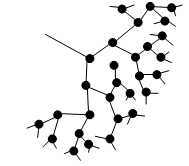 |
Play with this nuclear fission simulation from the University of Colorado:
There are two small problems. If you have a ball of uranium-235, the neutrons
released by the fragmentation of a nucleus might escape to the outside before
hitting another U-235. The odds of a neutron escaping are better the closer
it is to the surface of the mass. Those neutrons that 'leak' do not help continue
the chain reaction and should be subtracted from the average 2.47 neutrons
produced per fission. The smaller your ball of U-235, the greater the surface
area of the ball, in comparison to the volume of the ball (and hence the total
number of nuclei). So the smaller the mass of uranium, the larger is the percentage
of neutrons that leak out before encountering another nucleus. Another way
of looking at this is, for a small sphere of material a neutron has to pass
by a relatively few number of nuclei in order to escape the ball. The critical
mass is that amount necessary so losses to the outside keep the average neutron
production >2.00 per fission. A chain reaction can thus result.
If you assemble a critical-mass chunk of U-235, it will almost immediately blow up in your face, triggered by the first stray neutron to happen by, or natural spontaneous fission of only one U-235 nucleus. Clearly, that's not a property you want a bomb to have! So what you have to do is assemble the critical mass where and when you want the bomb to detonate. There are two general approaches to doing this.
The first method is the so-called gun-type assembly. This design is the simplest, and was the type used at Hiroshima. Two subcritical masses of U-235 are contained in a steel tube. (The Hiroshima bomb, Little Boy, was constructed from a recycled artillery gun barrel.) When triggered, a high-explosive charge propels one of the masses into the other. Combined, the uranium is supercritical and will explode with the first stray neutron.


Source: Wikimedia Commons
Unique units are used to measure the energy released by nuclear devices. Rather
than using joules, bomb yield is measured in units of tons of TNT. One ton
of TNT, when detonated, releases 4.18x109 J. The energy release of the Oklahoma
City bombing in March of 1995 was about 2 tons. Little Boy, the gun-type
bomb dropped on Hiroshima, released energy equivalent to twenty thousand
tons of TNT. This would be abbreviated 20 kT.
The second way of assembling a supercritical mass of fissionable material is
through implosion. This is how Fat Man, the bomb dropped at Nagasaki, was constructed.
The fissionable material (Plutonium-239 was used in Fat Man) is shaped into
a hollow sphere, called the core or "pit" (like the pit of a peach) which is subcritical because the plutonium is spread out, and the interior has a neutron-absorbing
shield. Any neutrons emitted into the interior are therefore absorbed and cannot
contribute to a chain reaction. Surrounding the Plutonium are high-explosives
which, when detonated, will drive the Plutonium inwards to a compact (and no
longer hollow) supercritical sphere. The chain reaction begins; within less than one microsecond, the reaction sweeps through the plutonium.

This type of device is much more complex than the gun-type assembly. The high
explosive charges must be properly shaped — the term 'lens' was used
to describe them, because they must focus, as much as possible, their explosive
force inwards. The high explosives must be detonated exactly simultaneously,
or the bomb will rip itself apart without going critical. Outside the "pit" is a sphere of U-238, called a tamper. Its purpose is twofold. First, it reflects some
of the neutrons that have escaped the Pu-239 sphere back inwards, where those
neutrons have a second chance to participate in the chain reaction. This reduces
the critical mass of Plutonium needed to make a bomb. Secondly, by its inertia
the tamper inhibits the outward expansion of the high explosives. This helps delay the outward motion of the exploding plutonium, giving time for the chain reaction to consume all the plutonium nuclei.
Regardless of the design, gun-type or implosion, once the supercritical mass is assembled, a neutron is needed to start the chain reaction – preferably a 'squirt' of many neutrons. This could be provided by the spontaneous fission of the uranium of plutonium fuel, but relying on that is ill-advised. Especially for the implosion design, it is critical that the initiating neutrons be available at the instant of maximum compression. If it comes too late the critical mass will already be disassembling and the yield will be greatly reduced. Perhaps only a few fission 'generations' will occur before the nuclei are spread too far apart to chain-react further, and the bomb will fizzle. To ensure reliable detonation, there needs to be a device to supply the first neutrons at precisely the right moment: the initiator. Only the size of a walnut, but by itself it is as complex as the rest of the whole bomb. It sits at the very center, the heart of the bomb.
Polonium-210 is a very active alpha-emitter (its halflife is 138 days). The alpha particles it releases can knock neutrons free from beryllium nuclei. It is this process that is used to supply the neutrons that initiate the chain reaction. The trick is to have no neutrons being emitted normally, when the bomb is sitting in storage, but have them promptly emitted at the instant of maximum compression of the core. The polonium is shaped into a shell, which is surrounded by a shell of beryllium. The polonium is not made a solid sphere because having it be hollow increases jetting and mixing of the polonium with the beryllium during the implosion. The beryllium is protected from the alpha-particles during storage by nickel plating on its inside surface – remember, alpha-radiation is the least penetrating: a thin layer of nickel is sufficient. When the initiator is crushed and heated by the imploding fuel, the polonium and beryllium (at this point in a gaseous state) are mixed. (Grooves or cone-shaped holes in the beryllium metal create jets which greatly assist the thorough mixing of the polonium with the beryllium.) Alpha-particles emitted from the polonium knock neutrons free from the beryllium, and these neutrons go on to initiate the first generation of fissions in the fuel.
Fat Man, the implosion device dropped on Nagasaki, released 12 kT of energy.
The fission products (fallout) are themselves radioactive:
90% of the total energy release occurs in the first microsecond; the remaining
10% is released by the delayed radioactivity of the fallout over the following
weeks.
Watch the video Nuclear Weapons: A Visual Timeline
Fusion bombs: (a.k.a. Hydrogen or H-bombs)
Energy can be released by either fissioning a large atom,
and also by joining (fusing) small atoms.
In the fall of 1941, the U.S. atomic bomb program was yet in its infancy: the
completion of the first nuclear reactor, Fermi's CP-1 to be built under the
bleacher of Stagg Field, was over a year away. The project was still being
run out of Berkeley – Los Alamos wasn't established until a full year later. It was
at this time that Enrico Fermi first conceived of what would eventually become
the hydrogen bomb. What if, instead of relying on the fissioning of large nuclei
to release energy, a device was made that fused (joined together) light nuclei.
This process, after all, is what powers the stars – Hans Bethe in 1938
had identified the so-called proton-proton cycle. The energy released per
mass of fuel should be much larger, and the existence of the stars makes evident
that there is no limit to the potential energy release, except fuel. Fermi
envisioned a D + D reaction, because it would be easier to "ignite" than
H + H. Initiating fusion would require exceedingly high temperatures (millions
of Kelvin) which could only be provided by an atomic bomb. Thus, Fermi's idea
could only come to fruition once the Manhattan Project's original goal, a fission
bomb, had been realized. Fermi continued his work on fission and reactor design — but
mentioned the idea to Edward Teller, who would make it his obsession even to
the extent of interfering with his atomic bomb work. In the summer of 1944,
after several months of Teller neglecting his theoretical work on implosions,
Oppenheimer permitted him to work of the thermonuclear bomb full-time for the
rest of the war. Rudolf Peirls was called in to replace him, and Peirls brought
Klaus Fuchs as an assistant.
The words "ignite" and "burn" are in quotes in the previous paragraph because they do not mean what you might think. We are talking about nuclear reactions here, not chemical reactions such as the oxidation reactions we usually call "fire" and "burning". Chemical reactions involve the exchange or sharing of electrons amongst electron clouds, creating or breaking bonds between atoms. In contrast, what we are describing here are collisions of nuclei and their subsequent interaction via the strong nuclear force: the energies involved in these processes are much higher (millions of times) than in chemical reactions and the electrons (if they are present at all) are totally irrelevant. Physicists first studying nuclear reactions borrowed these terms by analogy from chemistry, rather than inventing entirely new words.
| The energy of the Sun and other stars comes from this fusion. The star itself is simply a huge mass of gas (mostly hydrogen) held together by its own gravity. The center of the star (the core) is a zone of extreme pressure, because of the weight of the overlying gas pressing inwards. (This is the same cause of atmospheric pressure here on Earth: gravity pushing the overlying air downwards. That is why atmospheric pressure is less in the mountains — there is less atmosphere overhead.) The pressure is so high (and the temperature, too) that there are no atoms per se: the electrons are completely independent of the nuclei. In other words, the gas is in a plasma state. In this high-temperature stew of charged particles, the nuclei are moving so fast that, when they collide, their electromagnetic repulsion is insufficient to prevent the nuclei from 'touching', that is, getting so close that nuclear reactions (mediated by the strong force) occur. What are some of these possible reactions? Two ordinary hydrogen nuclei (just protons, really) can collide and combine, forming a deuterium nucleus, or deuteron. |  |
One of the protons has effectively been converted into a neutron, and a positron and neutrino are ejected in order to conserve charge, spin, and mass-energy. Nearly half a million electron-volts of energy is distributed as kinetic energy of the three particles, contributing to the high temperature of the gas. An additional 1.02 MeV is released when the positron runs into an electron and they are both annihilated (direct conversion of mass to energy by E=mc2.) The deuteron will soon collide with another proton, causing the reaction...
These two reactions have the net result of producing Helium-3. This is the first
step in the proton-proton chain that supplies the energy of the Sun and most
other stars. From this point, there are three possible reaction chains that end
up producing Helium-4. One of these possibilities (pp1) is a collision between
two Helium-3 nuclei...
These three reactions, taken together, have the net result of converting four
protons into one Helium-4 nucleus, releasing energy in the process. We could
write this net process in one equation...
but it is important to not interpret this equation too literally. The odds of
four protons all converging to one location simultaneously, and there reacting
to form a Helium are infinitesimally small. The actual process takes place in
steps, each involving the much more likely (indeed, inevitable) collision of
only two particles.
Teller's first design for a thermonuclear bomb (really just Fermi's original
idea of 1941) he called the "Super". A fission bomb, placed next to
a tank of liquid deuterium and detonated, would (it was hoped) initiate a D +
D fusion reaction in the tank. Each pair of deuterons which fuse would release
energy (in the form of KE of the new Helium-3 nucleus and a leftover neutron — heat).
This energy would then contribute to the general thermal energy of the tank,
and would promote the further fusion of other deuterium nuclei. The reaction
would propagate through the deuterium fuel, moving away from the fission-bomb
trigger. The energy released (the yield) would only be limited by how much deuterium
fuel was present.
There are several tentative "would's" in this description, which indicates the lack of detailed understanding of the complete process at that time. Will the deuterium really ignite? If so, will the reaction propagate? Or will the deuterium fuel be scattered by the fission bomb before the fusion reaction has had time to consume it? Or perhaps some other effect will prevent the fuel from efficiently burning.
The answers to these questions were not known, and could not be known, during the 1940's. Certainty required a detailed numerical simulation of the process — something which is common-place in science and engineering today thanks to the universal availability of powerful computers. But the electronic computer was just in the process of being born in the late 1940's. They employed vacuum tubes and filled rooms. The first electronic computer (the ENIAC, completed in 1946) was not fast enough for the task. Nevertheless, Teller was optimistic about his Super. He had done his own preliminary calculations by hand which indicated that, with a small quantity of tritium (hydrogen-3) mixed in with the deuterium fuel, the system would work. The tritium, because of its higher mass, would lower the ignition temperature considerably. To a certain extent, the amount of tritium added could be adjusted to compensate for hindering effects not included in his calculations.
Tritium was an expensive savior, however. It does not exist in nature; it must be 'bred' in a reactor, much as Pu-239 is. Doing so would require the construction of new breeder reactors, or else some production of plutonium for the growing A-bomb stockpile would have to be sacificed to support tritium production. It was important, therefore, for the H-bomb to be economically feasible, for it to not require much tritium. Teller guessed that 100 grams of tritium would suffice for each Super. He knew that this was only a rough estimate, however, and so he recommended, in a report issued at the end of the summer of 1947, a deliberate delay. Development of the Super should be pushed back two years or so, he said, until new, more-powerful computers were completed and could run the required calculations.
"Joe-1", the first atomic bomb detonated by the Soviet Union in 1949, caught everyone in America off-guard. Just two months prior, the CIA has issued an official estimate that the Soviet Union was at least two years, and more likely four years, from testing its first nuclear device. This estimate was based on information concerning problems with the Soviets' gaseous diffusion isotope-separation plant. If the USSR could mount a crash program to build an atomic bomb and succeed against all outside expectations, the possibility naturally arose that they may already have leap-frogged the U.S. and be already developing an H-bomb. This was the view of many people, including Teller, who strongly pushed for a crash program, despite his previous recommendation to wait. The MANIAC was not yet ready. Others, including Robert Oppenheimer, now chairman of the AEC General Advisory Committee, did not take such a pessimistic view, and furthermore, they opposed any development of moral and strategic grounds. They thought that the U.S. was relying too heavily on the atomic bomb as an inexpensive deterent to the Soviet Union's huge army treatening Europe. (Inexpensive, in the sense that atomic weapons were cheaper than maintaining a huge American army in Europe. It was also politically inexpensive – Europeans and Americans would oppose a large, permanent American military presence in Europe.) This reliance on atomic weapons resulted in inadequate funding for conventional forces. The mismatch in conventional forces must be tempting the Soviets to attempt further expansion of their borders. They felt that America would be cast in a bad moral light, in regards to worldwide public opinion, if it were to develop the H-bomb in peacetime. They also felt that any war fought with such weapons would so devastate the planet and civilization that 'victory' would be meaningless. They hoped that, if the U.S. set an example of restraint by not developing such a weapon, perhaps the Soviet Union would follow suit.
But the Cold War was already off and running. The Berlin Airlift was fresh in everyone's memory, as well as the Soviet occupation of Czhekoslovakia, and the revelations of Soviet spying in the U.S. during the war. (Klaus Fuchs was a Soviet spy, it turned out.) Truman's mood, and the nation's, was not one of cooperation. On 31 January 1950 Truman announced to the world his decision to pursue development of the hydrogen bomb. Although they were never close friends, this debate fostered a great animosity between Teller and Oppenheimer. Teller and others felt that Oppenheimer's views were injurious to the national defense. Although Teller himself denied such an opinion, several powerful members of the AEC as well as powerful government bureaucrats and congressmen thought Oppenheimer was probably a spy working for the Soviets.
In making his decision, Truman was accepting (and the military Joint Chiefs of Staff also) reduced production of conventional atomic weapons. It remained to be seen whether that sacrifice would pay off. Deciding not to wait for the MANIAC to be finished, Stanislaw Ulam, Cornelius Everett and Enrico Fermi conducted calculations through most of 1950, using improved formulas for such effects as inverse compton scattering. The results were not encouraging: not 100 grams of tritium, but as much as 3 to 5 kilograms would be required for each Super, to get the fusion reactions started. This result, by itself, made the Super infeasible, but the calculations further showed that once ignited, the fusion reaction would not propagate: energy bleeds off too fast (in the form of electromagnetic radiation), keeping the temperatures too low. The fusion front peters out. It was appearing that not only high temperatures, but also compression of the deuterium fuel would be neccessary. Although this had been considered before, it was not pursued because it was thought that conventional high explosives could not provide sufficient pressures to be effective.
In mid-1946 Teller invented another possible design – he called it the Alarm Clock. Basically, it was a Fat Man-style implosion bomb with, in addition to the core and the layers of tamper, pusher, and high explosives, incorporated one or more layers of deuterium (with some tritium). In the midst of the high temperatures and pressures of the fission chain-reaction the deuterium nuclei would be fused, releasing a much higher yield. The Alarm Clock looked very feasible but, as for the Super, the devil was in the details. In this case, if there is too much mixing of the light fusion fuel with the heavy fission materials, the heavy elements may cool the fusion fuel too much (heavier elements radiate more efficiently)) quenching the fusion reaction. Unlike the Super, the potential yield, while much higher than a standard fission bomb, was not unlimited. For this reason, Teller consistently pursued the Super in preference to the Alarm Clock.
This was the prelude to Ulam's realization, in December 1950, that one or more atomic bombs be used to supply the necessary compression. He was envisioning using atomic explosives to initiate fusion, much as conventional explosives are used to implode a Fat Man-style fission bomb. Teller realized that the electromagnetic radiation released by the fission bomb (or bombs) would be much more effective than the moving matter in compressing the deuterium. The radiation, of course, gets there first and if the fission bomb is efficient, the density of the radiation (E/c2V) is as high as ordinary matter.
-LLNL-restored.jpg)
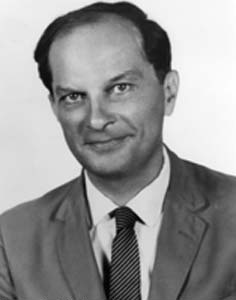 Edward Teller and Stanislaw Ulam
Edward Teller and Stanislaw Ulam
Thus, nearly a year after Truman's announcement, there was finally a scheme that looked like it would work. Three months later Teller added an additional, important component to the developing concept. If there were, in the center of the imploding deuterium fuel a core of U-235 or Pu-239, it would be compressed by the implosion and fission. The fusion fuel would be pinched between an external force pushing in and an internal force pushing outward. If these forces are properly balanced, the deuterium will be in equilibrium — it will not move much and will have plenty of time for the fusion reactions to run to completion. There would be no danger of the deuterium being scattered by the fission explosions. Teller call this central fission component the "sparkplug" – the whole bomb utilizing a sparkplug is called an "equilibrium thermonuclear." This basic layout is called the Teller-Ulam configuration, and although there are variations, is thought to be the basic idea of thermonuclear weapons to this day.
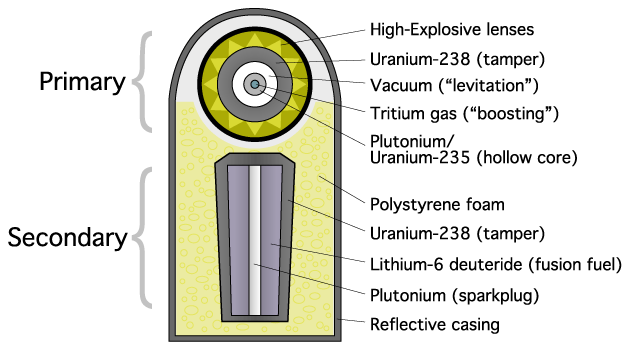

With a feasible concept finally, Los Alamos moved immediately toward development. At this point there was no debate about morality or strategic imbalance between conventional and nuclear forces. Truman had made the decision and even Oppenheimer was all for proceeding. (His enthusiasm at this late stage did little to appease his enemies, however.) Teller would not see it through – offended that he was not put in charge of the thermonuclear program by Los Alamos director Norris Bradbury (Oppenheimer's successor), he stormed out in September 1951.
As it was for the Fat Man, how to get the fuel to compress (implode) symmetrically was the first design question that needed working out. The Fat Man used 32 high-explosive lenses; later fission bombs would dispense with the lenses but would detonate a uniform high-explosive shell simultaneously at up to 92 points on its surface. In the fusion bomb, clearly it would be preferable to have a single fission bomb (rather than 32 or 92!) perform the compression. A single high-yield fission bomb has enough punch to do the job; the trick is to get that punch going inwards evenly around a mass of deuterium. The fission bomb trigger is called the primary; the deuterium to be compressed is the secondary.
The solution used was to implode the deuterium cylindrically, rather than spherically. Consult the diagram. The radiation from the fission-bomb primary (mostly soft x-rays) flows down a cylindrical channel past the central assembly containing the deuterium tank and the sparkplug (which is a long stick of plutonium at the central axis of the whole device.) The walls of the channel are lined with polyethylene which is vaporized by the x-rays flowing down the pipe. The plastic gets so hot that it re-radiates x-rays, symmetrically around the secondary.
A fission implosion bomb uses an aluminum shell and a thick layer of U-238 to act as pusher and tamper, respectively. The first thermonuclear bomb used a layer of U-238 for both purposes. It is this U-238 layer that the x-rays from the vapoized plastic hit. Direct pressure from the radiation, as well as the action-reaction effect of U-238 violently vaporizing from the layer's outer surface, push the U-238 layer inwards. The deuterium is compressed and, it turn, the plutonium sparkplug at the axis of the whole system, where the pressure waves converge. The sparkplug fissions, and the deuterium finds itself trapped, subject to extreme temperatures and pressures – sufficient to force deuterium nuclei close enough to fuse. The reaction is
Some deuterium nuclei fuse to create tritium nuclei instead of He-3:
These tritons can then fuse with deuterons, also releasing energy.
This, in outline, was the first hydrogen bomb. It was called 'Mike', and was
detonated on 1 November 1952. The yield was 10.4 Mt.
Significant details and complications have been left out of this description.
Most notable: liquid deuterium boils at 23.5 K – much of Mike's complexity
lies in the refrigeration and insulation systems used to maintain that low temperature.
Mike was designed as a test, a demonstration that the physics was well understood,
but it was too large, heavy, and complex to be a weapon, and it could not be
stored "on a shelf" ready to use. Once Mike had proven the physics,
follow-on designs were created that could be "weaponized," that is,
engineered for long-term storage and readiness. The most important change was
to use a dry fuel, lithium deuteride.
The atomic bomb program of the Soviet Union began late in 1942, after numerous espionage reports had shown that the U.S., Britain and Canada were working together toward that goal. Playing a crucial role in its inception, espionage would continue to play an important role in the Soviet program, at least until 1950 or so. Most of it was gathered during the war, by the end of which the NKVD (Soviet intelligence agency) had accumulated some ten thousand pages of documents from and about the Manhattan Engineering District.
During the course of World War II, the total energy released by all bombs, worldwide, was approximately 2 Mt. Due primarily to the greater payload capacity of the B-52 bomber, the bomb tonnage utilized during the Vietnam War was 6.3 Mt. The largest single bomb ever detonated was developed by the U.S.S.R., having a yield of 50 Mt.

